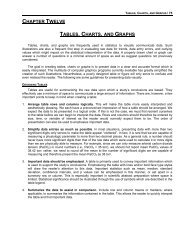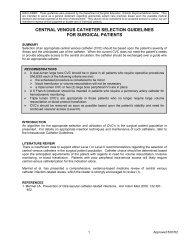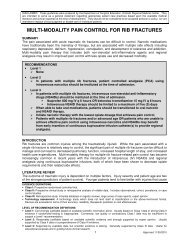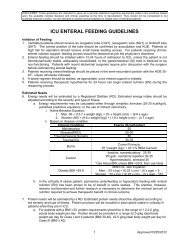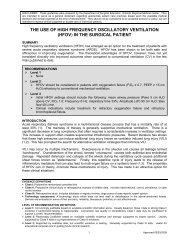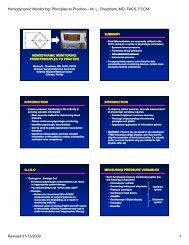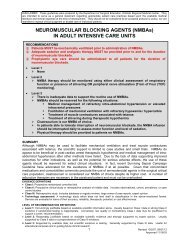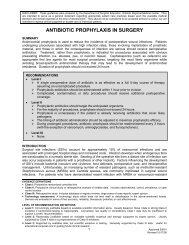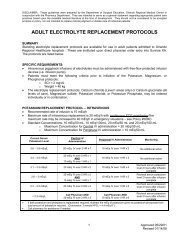Fungal Infections.pdf - SurgicalCriticalCare.net
Fungal Infections.pdf - SurgicalCriticalCare.net
Fungal Infections.pdf - SurgicalCriticalCare.net
- No tags were found...
You also want an ePaper? Increase the reach of your titles
YUMPU automatically turns print PDFs into web optimized ePapers that Google loves.
<strong>Fungal</strong> <strong>Infections</strong> – Kara Birrer, PharmD<br />
Objectives<br />
“There’s Fungus Among Us”<br />
2008<br />
Kara L. Birrer, Pharm.D.<br />
Clinical Pharmacist, Trauma/General Surgery<br />
Orlando Regional Medical Center<br />
• Describe the epidemiology<br />
• Identify risk factors for infection<br />
• Review common fungal infections<br />
• Discuss special high-risk populations<br />
• Differentiate between the various antifungal<br />
agents<br />
2<br />
Patient Case - DB<br />
• 62yom presents for Ex-lap, colonoscopy, rigid<br />
anoscopy, LOA, small bowel resection<br />
• POD# 10 – sepsis, perc-drain RLQ<br />
• Empiric antibiotics:<br />
– Zosyn 4.5g IV q6<br />
– Vancomycin 750mg IV q12<br />
– Fluconazole 800mg IV x1, then 400mg IV q24<br />
Epidemiology<br />
• <strong>Fungal</strong> species account for up to 25% of all<br />
healthcare-associated blood infections<br />
• Candida spp. account for 8-15% of all blood<br />
stream infections<br />
• C. albicans accounts for 40-60% of the fungal<br />
infections<br />
• Aspergillus spp. are the 2 nd most common cause<br />
of fungal infections in cancer patients<br />
3<br />
Richardson MD. JAC 2005;56(S1):i5.<br />
4<br />
Risk Factors<br />
Risk Factors<br />
Underlying Conditions Immune Defects Iatrogenic Factors<br />
Underlying Conditions Immune Defects Iatrogenic Factors<br />
• Burns (large ± inhalation inj.)<br />
• Cancer<br />
• Candida colonization<br />
• Cytomegalovirus (CMV)<br />
• Diabetes mellitus<br />
• Graft versus host disease<br />
• Hematological malignancies<br />
• HIV<br />
• Malnutrition<br />
• Organ transplantation<br />
• Granulocytopenia<br />
• Neutropenia<br />
• T-cell defects<br />
• Broad-spectrum antibiotics<br />
• Central venous catheters<br />
• Chemotherapy<br />
• High-dose steroids<br />
• Immunosuppressive therapy<br />
• Intra-abdominal surgery<br />
• Total parenteral nutrition<br />
• Burns (large ± inhalation inj.)<br />
• Cancer<br />
• Candida colonization<br />
• Cytomegalovirus (CMV)<br />
• Diabetes mellitus<br />
• Graft versus host disease<br />
• Hematological malignancies<br />
• HIV<br />
• Malnutrition<br />
• Organ transplantation<br />
• Granulocytopenia<br />
• Neutropenia<br />
• T-cell defects<br />
• Broad-spectrum antibiotics<br />
• Central venous catheters<br />
• Chemotherapy<br />
• High-dose steroids<br />
• Immunosuppressive therapy<br />
• Intra-abdominal abdominal surgery<br />
• Total parenteral nutrition<br />
Richardson MD. JAC 2005;56(S1):i5.<br />
Sobel JD, et.al. Contemporary Diagnosis & Management of <strong>Fungal</strong> <strong>Infections</strong>. 2003, pp.135.<br />
5<br />
Richardson MD. JAC 2005;56(S1):i5.<br />
Sobel JD, et.al. Contemporary Diagnosis & Management of <strong>Fungal</strong> <strong>Infections</strong>. 2003, pp.135.<br />
6<br />
01/14/2009 1
<strong>Fungal</strong> <strong>Infections</strong> – Kara Birrer, PharmD<br />
Diagnosis<br />
• Culture – single best tool<br />
• Smear of body fluids and/or tissues<br />
• Skin test – coccidiodin antigen<br />
• Histopathology or special stains of biopsy<br />
specimens<br />
• Serology – only moderately helpful<br />
Types of Invasive <strong>Fungal</strong><br />
<strong>Infections</strong><br />
• Yeasts<br />
– Candida spp.<br />
– Cryptococcus neoformans<br />
• Aspergillus spp.<br />
• Fusarium spp.<br />
• Mucor spp.<br />
• Other fungi<br />
7<br />
8<br />
Emerging <strong>Fungal</strong> Pathogens<br />
Yeast<br />
Candida spp.<br />
Cryptococcus spp.<br />
Trichosporium<br />
Zygomycetes<br />
Fungus<br />
Mold<br />
Mucor spp.<br />
Pheohyphomycoses<br />
Others<br />
Black mold<br />
Dematiaceous<br />
Wangiella spp.<br />
Ashley ESD. An update on antifungal therapy. FSHP 2006<br />
Septate<br />
Dimorphic<br />
Histoplasmosis<br />
Blastomycosis<br />
s<br />
Coccidomycosis<br />
Hyalohyphomycoses<br />
Aspergillus spp.<br />
Fusarium spp.<br />
Paecilomyces spp.<br />
9<br />
Yeast – Candida spp.<br />
• Most common fungal pathogen<br />
• Opportunistic pathogens<br />
• 4 th most common nosocomial bloodstream<br />
infection<br />
• Portals of entry:<br />
– Gastrointestinal tract<br />
– Central venous catheters<br />
• C. albicans versus non-C. albicans<br />
Bustamante CL. Cur Opin Infect Dis. 2005; 18:490.<br />
10<br />
Yeast – Candida spp.<br />
• Most common types of infections<br />
– Mucosal candidiasis (thrush)<br />
– Candida esophagitis<br />
– Candida pneumonia<br />
– Candidemia<br />
• 25-50% of nosocomial candidiasis<br />
• 20% associated with central venous catheters<br />
Yeast – Candida spp.<br />
• C. albicans = 80-90% of<br />
oropharyngeal<br />
colonization<br />
• Also common fecal<br />
normal flora<br />
• C. albicans & C. glabrata<br />
account for 70% of all<br />
Candida infections<br />
• Drug of Choice (DOC):<br />
Candida spp. dependant<br />
11<br />
www.asm.org/Division/c/fungi.htm<br />
12<br />
01/14/2009 2
<strong>Fungal</strong> <strong>Infections</strong> – Kara Birrer, PharmD<br />
Yeast – Candida spp.<br />
Yeast – Candida spp. Treatment<br />
• At ORMC (July 2006 – June 2007 Sterile Sites):<br />
– 52% C. albicans<br />
– 48% C. non-albicans<br />
• Other Candida spp concerns:<br />
– Biofilm formation on indwelling catheters<br />
– C. albicans resistance to fluconazole<br />
13<br />
Ostrosky-Zeichner L, et.al. Crit Care Med. 2006; 34(3):857.<br />
14<br />
Yeast – Candida spp. Treatment<br />
C. krusei<br />
C. glabrata<br />
Echinocandin<br />
Candida spp.<br />
C. albicans<br />
Fluconazole –<br />
st infection<br />
1 st<br />
Echinocandin<br />
nd infection<br />
–2 nd<br />
C. dubliniensis<br />
C. guilliermondii<br />
C. lusitaniae<br />
C. parapsilosis<br />
C. tropicalis<br />
Fluconazole<br />
Patient Case - DB<br />
• RLQ Abscess Cx: (results available POD#15)<br />
– Candida (Torulopsis) glabrata<br />
– Candida tropicalis<br />
• Is the fluconazole enough Concerns<br />
• POD# 15 –<br />
– Discontinue fluconazole<br />
– Caspofungin 70mg IV x 1, then 50mg IV daily<br />
Ostrosky-Zeichner L, et.al. Crit Care Med. 2006; 34(3):857.<br />
15<br />
16<br />
Yeast – Cryptococcus spp.<br />
• Cryptococcus neoformans<br />
• Source – soil contamination<br />
with pigeon droppings<br />
• Portal of entry – inhalation<br />
• Primarily infects the central<br />
nervous system –<br />
meningoencephalitis<br />
Yeast – Cryptococcus spp.<br />
• Nearly always associated with an<br />
immunocompromised state<br />
– 6-10% of HIV+ patients in the US will develop<br />
• Treatment:<br />
– Amphotericin B + Flucytosine x 2 weeks<br />
– Followed by Fluconazole 400mg po daily x 6 weeks<br />
Sobel JD, et.al. Contemporary Diagnosis & Management of <strong>Fungal</strong> <strong>Infections</strong>. 2003, pp.123.<br />
17<br />
Sobel JD, et.al. Contemporary Diagnosis & Management of <strong>Fungal</strong> <strong>Infections</strong>. 2003, pp.123.<br />
18<br />
01/14/2009 3
<strong>Fungal</strong> <strong>Infections</strong> – Kara Birrer, PharmD<br />
Aspergillus spp.<br />
Aspergillus spp.<br />
• Aspergillus spp. are widespread in the<br />
environment<br />
• Aspergillus spp. are moulds<br />
• Air = primary route of transmission in hospitals<br />
• Aspergillus fumigatus – most frequent pathogen<br />
• Invasive infection associated<br />
with immunodeficiency<br />
• Primary sites of infection:<br />
– Lungs<br />
– Central Nervous System<br />
– Sinuses<br />
• <strong>Infections</strong> can be local or<br />
invasive<br />
• Definitive diagnosis tissue<br />
biopsy<br />
Aspergillus fumigatus<br />
http://www.asm.org/Division/c/photo/asp1.JPG<br />
Sobel JD, et.al. Contemporary Diagnosis & Management of <strong>Fungal</strong> <strong>Infections</strong>. 2003, pp.135.<br />
19<br />
http://www.primidi.com/images/aspergillus_fumigatus.jpg<br />
Sobel JD, et.al. Contemporary Diagnosis & Management of <strong>Fungal</strong> <strong>Infections</strong>. 2003, pp.135.<br />
20<br />
Aspergillus spp. Treatment<br />
Aspergillus spp. Treatment<br />
High Risk<br />
• Neutropenia<br />
• Febrile<br />
• Lung infiltrates<br />
• Isolation of Aspergillus in<br />
sputum cultures<br />
Low Risk<br />
• Solid organ transplant<br />
• Malignancy<br />
• Chronic granulomatous<br />
disease<br />
• HIV (+)<br />
• DOC: Voriconazole (VFend ® )<br />
• Alternative Treatments:<br />
– Caspofungin (Cancidas ® ) – refractory disease<br />
– Amphotericin B – also 1 st line, high failure rate<br />
– Itraconazole – oral only<br />
– Posaconazole – oral only<br />
Start Treatment:<br />
• High Risk start empiric therapy<br />
• Low Risk await biopsy results<br />
21<br />
22<br />
Sobel JD, et.al. Contemporary Diagnosis & Management of <strong>Fungal</strong> <strong>Infections</strong>. 2003, pp.135.<br />
Sobel JD, et.al. Contemporary Diagnosis & Management of <strong>Fungal</strong> <strong>Infections</strong>. 2003, pp.135.<br />
Fusarium spp.<br />
Fusarium spp.<br />
• Ubiquitous fungus found in the soil<br />
• 2 nd most common cause of invasive mycotic<br />
infections<br />
• Can also superficial skin infections<br />
• May be confused with Aspergillus spp in the lab<br />
• Diagnosis –<br />
– Easily recovered from blood cultures<br />
– 60-70% of patients with fusariosis will have (+) blood<br />
cultures<br />
• Treatment –<br />
– Frequently resistant to amphotericin B, azoles, &<br />
flucytosine<br />
– DOC: Voriconazole (VFend ® )<br />
– Alternate: Posaconazole (oral only)<br />
23<br />
24<br />
Sobel JD, et.al. Contemporary Diagnosis & Management of <strong>Fungal</strong> <strong>Infections</strong>. 2003, pp.135.<br />
Sobel JD, et.al. Contemporary Diagnosis & Management of <strong>Fungal</strong> <strong>Infections</strong>. 2003, pp.135.<br />
01/14/2009 4
<strong>Fungal</strong> <strong>Infections</strong> – Kara Birrer, PharmD<br />
Mucor spp.<br />
Mucor spp.<br />
• Included in the zygomycosis group of infections<br />
• Environmental mold<br />
• Transmission through inhalation or ingestion of<br />
spores<br />
• Risk Factors:<br />
–DKA<br />
– Immunosuppression<br />
– Others<br />
• Treatment:<br />
– Early diagnosis is key<br />
– Surgical debridement or resection if<br />
possible<br />
– Antifungal therapy: Voriconazole<br />
(VFend ® )<br />
– Reverse immunosuppression if<br />
possible<br />
http://www.doctorfungus.org/thefungi/mucor.htm<br />
www.sci.muni.cz/mikrob/Miniatlas/muc.htm<br />
25<br />
http://www.doctorfungus.org/thefungi/mucor.htm<br />
pathmicro.med.sc.edu/mycology/mycology-1.htm<br />
26<br />
Treatment Principles<br />
Special Populations<br />
• Special population considerations<br />
• Source control<br />
• Antifungal class review<br />
– Mechanism of action<br />
– Spectrum of activity<br />
–Dosing<br />
– Adverse reactions<br />
• Antifungal resistance issues<br />
• Duration of therapy<br />
• Burns:<br />
–1 st line treatment: Surgical debridement<br />
– Adjuvant systemic antifungal therapy<br />
• Critically Ill Patients –<br />
– Hypothermia/Hyperthermia<br />
– Isolation of yeast/mold from any culture with risk<br />
factors<br />
• Solid Organ Transplant<br />
– Time since transplant<br />
– Type of transplant dictates risk<br />
27<br />
Horvath EE, et.al. Ann Surg. 2007; 245:978<br />
Holzheimer RG, et.al. Eur J Med Res. 2002; 7(5):200.<br />
28<br />
Treatment<br />
Sites of Action<br />
• Surgical debridement<br />
• Removal of invasive devices (if possible)<br />
– Central venous lines (new stick)<br />
– Drains, ,pumps, p etc<br />
• Antifungal therapy<br />
– Polyenes/Amphotericin B Products<br />
– Flucytosine<br />
–Azoles<br />
– Echinocandins<br />
Posaconazole<br />
AMBd = Amphotericin B deoxycholate<br />
AMB = Amphotericin B<br />
29<br />
30<br />
Dismukes WE. Clin Infect Dis. 2006; 42(9):1289.<br />
01/14/2009 5
<strong>Fungal</strong> <strong>Infections</strong> – Kara Birrer, PharmD<br />
Amphotericin B (Polyenes)<br />
• MOA: Bind ergosterol in cell membrane causing<br />
disruption and cell death<br />
• Lipophilic antifungal<br />
• Spectrum of Activity:<br />
– Candida spp.<br />
– Aspergillus spp.<br />
– Cryptococcus spp.<br />
– Others<br />
Amphotericin B (Polyenes)<br />
Amphotericin B<br />
Amphotericin B<br />
Lipid Complex<br />
(Abelcet ® )<br />
Liposomal<br />
Amphotericin B<br />
(Ambisome ® )<br />
Dose 0.7-1.5 mg/kg IV daily 3-5 mg/kg IV daily 3-7 mg/kg IV daily<br />
Infusion-related<br />
reactions<br />
++ ++ +<br />
Nephrotoxicity +++ ++ ++<br />
CSF<br />
Pe<strong>net</strong>ration<br />
+ ++++ +<br />
31<br />
32<br />
Sobel JD, et.al. Contemporary Diagnosis & Management of <strong>Fungal</strong> <strong>Infections</strong>. 2003, pp.11.<br />
Micromedex. © 2008. [Accessed 13-Mar-2008].<br />
Amphotericin B (Polyenes)<br />
Flucytosine<br />
• Adverse Reactions:<br />
– Infusion-related reactions<br />
– Nephrotoxicity<br />
– LFT abnormalities<br />
• Drug Interactions:<br />
– Digoxin (↑ levels)<br />
– Tacrolimus (↑ toxicity)<br />
– Cyclosporine (↑ toxicity)<br />
Amphotericin B deoxycholate<br />
• MOA: converted to 5-fluoruracil in the fungal cell<br />
and then disrupts RNA & protein synthesis<br />
• Spectrum of Activity:<br />
– Candida spp.<br />
– Crpytococcus spp.<br />
• Rapidly develops resistance<br />
Amphotericin B lipid complex<br />
(Abelcet ® )<br />
https://www.epocrates.com/pillimages/A1055050.jpg<br />
http://www.drug3k.com/img/abelcet_12206_1.jpg<br />
33<br />
www.gallowaypharmacy.com/products.phpcat=19<br />
Sobel JD, et.al. Contemporary Diagnosis & Management of <strong>Fungal</strong> <strong>Infections</strong>. 2003, pp.20.<br />
34<br />
Flucytosine<br />
Azole Anti-fungals<br />
• Dose: 100-150 mg/kg/day PO divided q6<br />
• Pharmacoki<strong>net</strong>ics:<br />
– 75-90% bioavailable<br />
– CSF levels = 60-100% of blood levels<br />
– 75-90% excreted unchanged in urine<br />
• Adverse reactions:<br />
– Myelosuppression (22%)<br />
– Renal insufficiency<br />
– Nausea/Vomiting/Diarrhea<br />
• MOA: inhibition of CYP450-dependant inosterol<br />
14-α-demethylase inhibition of ergosterol<br />
synthesis<br />
• Specific Agents:<br />
– Fluconazole (Diflucan ® )<br />
– Itraconazole (Sporonox ® ) – oral only<br />
– Voriconazole (VFend ® )<br />
– Posaconazole (Noxafil ® ) – oral only<br />
Sobel JD, et.al. Contemporary Diagnosis & Management of <strong>Fungal</strong> <strong>Infections</strong>. 2003, pp.20.<br />
35<br />
Sobel JD, et.al. Contemporary Diagnosis & Management of <strong>Fungal</strong> <strong>Infections</strong>. 2003, pp.20.<br />
Micromedex. © 2008. [Accessed 05-May-2008]<br />
36<br />
01/14/2009 6
<strong>Fungal</strong> <strong>Infections</strong> – Kara Birrer, PharmD<br />
Fluconazole (Diflucan ® )<br />
Fluconazole (Diflucan ® )<br />
• Spectrum of Activity:<br />
– Candida spp (except C. krusei)<br />
– Cryptococcus neoformans<br />
– Histoplasma capsulatum<br />
– Blastomyces dermatitidis<br />
– Others<br />
• Good empiric anti-fungal choice<br />
• Dose:<br />
– 800mg IV on Day #1, then 400mg IV/PO q24<br />
– Adjust for renal dysfunction<br />
• >90% oral bioavailability<br />
• Drug Interactions:<br />
– Amiodarone<br />
– Warfarin ( ↑ INR)<br />
– Phenytoin ( ↓ levels)<br />
– Glyburide/Glipizide (mask hypoglycemia)<br />
• Adverse reactions:<br />
– Rash (~10%)<br />
– Increased LFTs (~10%)<br />
Sobel JD, et.al. Contemporary Diagnosis & Management of <strong>Fungal</strong> <strong>Infections</strong>. 2003, pp.20.<br />
Micromedex. © 2008. [Accessed 05-May-2008]<br />
37<br />
Sobel JD, et.al. Contemporary Diagnosis & Management of <strong>Fungal</strong> <strong>Infections</strong>. 2003, pp.20.<br />
Micromedex. © 2008. [Accessed 05-May-2008]<br />
38<br />
Voriconazole (Vfend ® )<br />
Voriconazole (Vfend ® )<br />
• Spectrum of Activity:<br />
– Aspergillus spp.<br />
– Candida spp.<br />
– Fusarium spp.<br />
– Histoplasma capsulatum<br />
– Blastomycese dermatitidis<br />
– Others<br />
• DOC: Aspergillus spp.<br />
• Dose:<br />
– IV/PO: 6 mg/kg q12 x 2 doses, then 4mg/kg q12<br />
• IV excipient accumulates in renal failure – use<br />
for loading dose only<br />
• Drug Interactions:<br />
– Amiodarone<br />
– Warfarin ( ↑ INR)<br />
– Digoxin ( ↑ levels)<br />
– Glyburide/Glipizide (mask hypoglycemia)<br />
• Adverse Reactions:<br />
– Transient visual disturbances (24%)<br />
– Rash (6%)<br />
– Increased LFTs (4-20%)<br />
Sobel JD, et.al. Contemporary Diagnosis & Management of <strong>Fungal</strong> <strong>Infections</strong>. 2003, pp.20.<br />
Micromedex. © 2008. [Accessed 05-May-2008]<br />
39<br />
Sobel JD, et.al. Contemporary Diagnosis & Management of <strong>Fungal</strong> <strong>Infections</strong>. 2003, pp.20.<br />
Micromedex. © 2008. [Accessed 05-May-2008]<br />
40<br />
Itraconazole (Sporonox ® )<br />
Itraconazole (Sporonox ® )<br />
• Spectrum of Activity:<br />
– Candida spp.<br />
– Aspergillus spp.<br />
– Histoplasma capsulatum<br />
– Blastomyces dermatitidis<br />
– Others<br />
• Dosage:<br />
– Serious infections: 200mg po q12<br />
–Oral Candida infections: 200mg po daily x 14 days<br />
• Bioavailability:<br />
– Capsules – increased with food<br />
– Solution – must take on empty stomach<br />
• Drug Interactions:<br />
– Antacids ( ↓ absorption of itraconazole)<br />
– Digoxin ( ↑ levels)<br />
• Adverse Reactions:<br />
– Nausea, vomiting, diarrhea<br />
– Hypertension, ↓ K, edema<br />
Sobel JD, et.al. Contemporary Diagnosis & Management of <strong>Fungal</strong> <strong>Infections</strong>. 2003, pp.20.<br />
Micromedex. © 2008. [Accessed 05-May-2008]<br />
41<br />
Sobel JD, et.al. Contemporary Diagnosis & Management of <strong>Fungal</strong> <strong>Infections</strong>. 2003, pp.20.<br />
Micromedex. © 2008. [Accessed 05-May-2008]<br />
42<br />
01/14/2009 7
<strong>Fungal</strong> <strong>Infections</strong> – Kara Birrer, PharmD<br />
Posaconazole (Noxafil ® )<br />
• Spectrum of Activity:<br />
– Candida spp.<br />
– Aspergillus spp.<br />
– Fusarium spp.<br />
– Cryptococcus neoformans<br />
– Others<br />
• Dose:<br />
– 400mg po q12<br />
– Ophthalmic: 10mg/0.1mL to affected eye q1h (+ PO)<br />
Sobel JD, et.al. Contemporary Diagnosis & Management of <strong>Fungal</strong> <strong>Infections</strong>. 2003, pp.20.<br />
Micromedex. © 2008. [Accessed 05-May-2008]<br />
43<br />
Posaconazole (Noxafil ® )<br />
• Increased absorption when given with food<br />
– Must be taken with a fatty meal<br />
• 77% fecal excretion<br />
• Drug Interactions:<br />
– Phenytoin (↑ levels)<br />
– Midazolam (↑ sedation)<br />
– Others<br />
• Adverse Reactions:<br />
– Hypotension (~40%)<br />
– Rash (2% of HIV patients)<br />
Sobel JD, et.al. Contemporary Diagnosis & Management of <strong>Fungal</strong> <strong>Infections</strong>. 2003, pp.20.<br />
Micromedex. © 2008. [Accessed 05-May-2008]<br />
44<br />
Azole Antifungal Summary<br />
Echinocandins<br />
• Fluconazole – 1 st line for Candida albicans<br />
• Itraconazole – almost no place in therapy<br />
• Voriconazole – DOC for Aspergillus spp<br />
• Posaconazole – place in therapy to be<br />
determined<br />
• Synthetic, lipopeptide antifungals deribed from<br />
Zalernon arboricola<br />
• MOA: non-competitive inhibition of the synthesis<br />
of the enzyme glucan synthase<br />
• Specific Agents:<br />
– Caspofungin (Cancidas ® )<br />
– Micafungin (Mycamine ® )<br />
– Anidulafungin (Eraxis ® )<br />
Sobel JD, et.al. Contemporary Diagnosis & Management of <strong>Fungal</strong> <strong>Infections</strong>. 2003, pp.20.<br />
Micromedex. © 2008. [Accessed 05-May-2008]<br />
45<br />
Sobel JD, et.al. Contemporary Diagnosis & Management of <strong>Fungal</strong> <strong>Infections</strong>. 2003, pp.20.<br />
Micromedex. © 2008. [Accessed 05-May-2008]<br />
46<br />
Echinocandins<br />
• Advantages:<br />
– No adjustment for renal dysfunction<br />
– Well tolerated<br />
– Effective against Candida biofilms<br />
Spectrum of<br />
Activity<br />
Indications<br />
Dosage<br />
Caspofungin<br />
C. albicans<br />
C. glabrata<br />
C. krusei<br />
C. lusitaniae<br />
C. tropicalis<br />
C. guilliermondii<br />
Aspergillus spp.<br />
• Neutropenic fever<br />
• Candidemia<br />
• Intra-abd. abscess<br />
• Candida peritonitis<br />
• Pleural infections<br />
• Esophageal<br />
candidiasis<br />
• Refractory invasive<br />
Aspergillosis<br />
70mg IV x 1, then<br />
50mg IV q24<br />
Micafungin<br />
C. albicans<br />
C. glabrata<br />
C. krusei<br />
C. lusitaniae<br />
C. tropicalis<br />
C. guilliermondii<br />
• Candidemia<br />
• Invasive candidiasis<br />
• Stem-cell transplant<br />
prophylaxis<br />
• Esophageal<br />
candidiasis<br />
100mg IV daily<br />
Anidulafungin<br />
C. albicans<br />
C. glabrata<br />
C. krusei<br />
C. lusitaniae<br />
C. tropicalis<br />
C. guilliermondii<br />
• Candidemia<br />
• Invasive candidiasis<br />
• Intra-abdominal<br />
abscess<br />
• Candida peritonitis<br />
• Esophageal<br />
candidiasis<br />
200mg IV daily, then<br />
100mg IV daily<br />
Sobel JD, et.al. Contemporary Diagnosis & Management of <strong>Fungal</strong> <strong>Infections</strong>. 2003, pp.20.<br />
Micromedex. © 2008. [Accessed 05-May-2008]<br />
47<br />
Sobel JD, et.al. Contemporary Diagnosis & Management of <strong>Fungal</strong> <strong>Infections</strong>. 2003, pp.20.<br />
Micromedex. © 2008. [Accessed 05-May-2008]<br />
48<br />
01/14/2009 8
<strong>Fungal</strong> <strong>Infections</strong> – Kara Birrer, PharmD<br />
Pharmaco-<br />
kinectics<br />
ADR<br />
Drug<br />
Interactions<br />
Special<br />
Notes<br />
Caspofungin<br />
• Hepatic metabolism<br />
• Fecal elimination<br />
• Phlebitis/<br />
thrombophlebitis<br />
• ↑ LFTs<br />
• Possible histaminemediated<br />
symptoms<br />
• Phenytoin<br />
• Tacrolimus<br />
• Cyclosporine<br />
• dose-adjust for<br />
hepatic failure<br />
Micafungin<br />
• Hepatic metabolism<br />
• Fecal elimination<br />
• Infusion-site<br />
reactions<br />
• ↑ LFTs<br />
• Possible histaminemediated<br />
symptoms<br />
• Nifedipine<br />
• Sirolimus<br />
Anidulafungin<br />
• Spontaneous<br />
degradation<br />
• 30% Fecal<br />
elimination<br />
• Possible histaminemediated<br />
symptoms<br />
• Hypokalemia<br />
• Diarrhea<br />
• Cyclosporine<br />
• Made w/ 20%<br />
alcohol – disulfiram<br />
-like reactions<br />
Anti-<strong>Fungal</strong> Resistance<br />
• Initially described in HIV population<br />
• Mechanisms:<br />
– Clinical failure – the drug cannot eradicate the fungi<br />
– Cellular resistance (decreased response)<br />
• Intrinsic – fungi is always resistant<br />
• Acquired – fungi is initially susceptible & develops resistance<br />
• Management:<br />
– Speciation of Candida isolates<br />
– Removal of invasive devices (biofilm source)<br />
– Aggressive dosing or alternative agents<br />
Sobel JD, et.al. Contemporary Diagnosis & Management of <strong>Fungal</strong> <strong>Infections</strong>. 2003, pp.20.<br />
Micromedex. © 2008. [Accessed 05-May-2008]<br />
49<br />
Kuhn DM, et.al. Antimicrob Agents Chemother. 2002; 46(6):1773-80.<br />
Rodriguez D, et.al. Clin Microbiol Infect. 2007; 13:788-93<br />
50<br />
Duration of Therapy<br />
Brief Review<br />
• Candidemia<br />
– Repeat blood cultures 3-5 days into therapy<br />
– Continue systemic anti-fungal agent for 14 days<br />
AFTER negative blood cultures<br />
• Candiduria<br />
– Change catheter or remove if possible<br />
– If candiduria persists after catheter change - treat 7-<br />
14 days<br />
• Other fungal infections –<br />
– Duration based on clinical judgment or wound status<br />
– (Or ID consult recommendations)<br />
51<br />
• Fungi account for 25% of all healthcare-related<br />
infections<br />
• Multiple risk factors – including ICU stay, broadspectrum<br />
antibiotics, CVLs, steroids, & diabetes<br />
• Most common organisms: Candida spp.<br />
• Burn, critically ill, & transplant patients at highest<br />
risk<br />
• Choose antifungal agent based on most likely<br />
organism<br />
52<br />
01/14/2009 9



